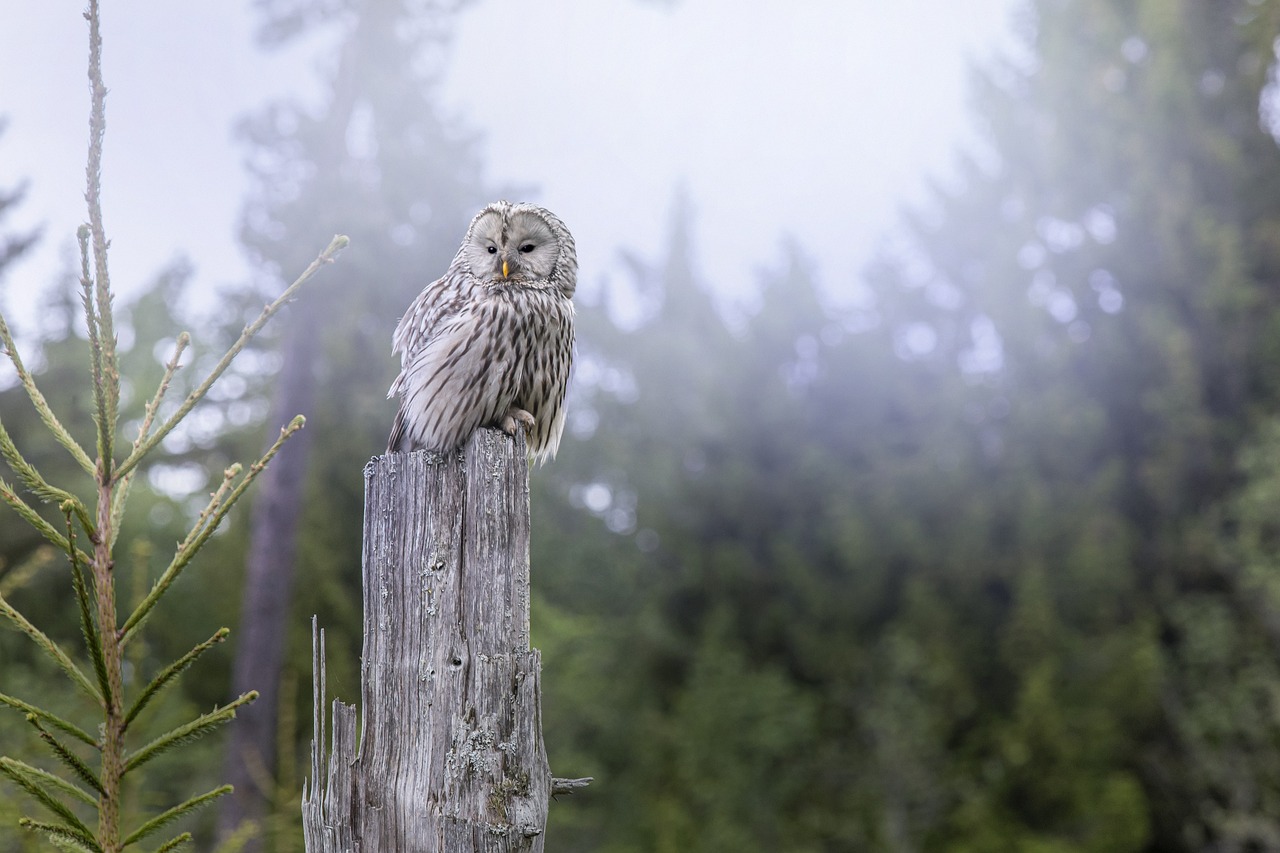The Ural Owl (Strix uralensis) is a large and powerful owl species native to Europe and Asia. It is known for its striking appearance, formidable hunting skills, and distinctive call. Here’s an overview of this fascinating bird:
Description
- Size:
- The Ural Owl is a medium-to-large owl, with a body length ranging from 50 to 62 centimeters (20 to 24 inches) and a wingspan of 110 to 134 centimeters (43 to 53 inches). It typically weighs between 600 and 1,300 grams (1.3 to 2.9 pounds), with females generally being larger than males.
- Appearance:
- This owl has a round head with no ear tufts, large black eyes, and a yellow beak. Its plumage is generally pale gray or buff, with dark streaks running vertically down its body. The wings and tail are relatively long, giving it a graceful appearance in flight.
- The Ural Owl has a distinct facial disc that is pale with dark outlines, enhancing its penetrating gaze.
Habitat and Range
- Range:
- The Ural Owl is found across a broad range in Europe and Asia. It inhabits regions from Scandinavia and Eastern Europe through Russia and into parts of Central and East Asia, including Japan.
- Habitat:
- This owl prefers dense, mature forests, particularly mixed or coniferous woodlands. It is often found in areas with large, old trees that provide suitable nesting sites and ample prey. The Ural Owl is also adaptable and can live in a variety of forest types, including montane and boreal forests.
Behavior and Diet
- Diet:
- The Ural Owl is a skilled and opportunistic hunter. Its diet primarily consists of small mammals, such as voles, mice, and shrews, but it also preys on birds, insects, and occasionally amphibians. It hunts mainly at night but can also be active during the day, especially during the breeding season when it needs to feed its young.
- Hunting:
- The owl uses its exceptional hearing and silent flight to locate and ambush prey. It typically hunts from a perch, swooping down on its prey with great precision.
- Social Structure:
- Ural Owls are generally solitary outside the breeding season. They are territorial and will defend their territory vigorously against intruders, including other owls and larger predators.
Reproduction
- Breeding Season:
- The breeding season for Ural Owls typically begins in late winter to early spring. They are monogamous and form long-term pair bonds.
- Nesting:
- Ural Owls prefer to nest in large tree cavities, but they will also use old nests of other birds, such as raptors or storks, and occasionally even nest boxes if available. The female lays 2 to 4 eggs, which she incubates for about a month while the male provides food.
- Chick Development:
- The chicks hatch altricial (blind and helpless) and are dependent on their parents for food and protection. They fledge after about 4 to 5 weeks but may remain dependent on the adults for several months before becoming fully independent.
Vocalization
- Calls:
- The Ural Owl has a distinctive, haunting call that is often described as a series of deep, resonant hoots. The male’s call is more prolonged and rhythmic, while the female’s is slightly higher in pitch. These calls can carry over long distances, especially in dense forests, and are often heard during the breeding season.
Conservation Status
- Conservation:
- The Ural Owl is currently listed as a species of “Least Concern” by the IUCN due to its wide range and stable population. However, it faces threats from habitat loss due to logging and forest management practices that reduce the availability of large, old trees that are crucial for nesting.
Interaction with Humans
- Human-Wildlife Conflict:
- In some regions, Ural Owls can come into conflict with humans when they defend their nests aggressively against perceived threats, including people who inadvertently approach too closely. However, these incidents are relatively rare.
- Cultural Significance:
- In various cultures within its range, the Ural Owl is often associated with the wilderness and is admired for its resilience and adaptability in harsh environments.
Summary
The Ural Owl (Strix uralensis) is a majestic and formidable predator of the forests of Europe and Asia. With its striking appearance, powerful hunting skills, and haunting calls, it plays a vital role in the ecosystems it inhabits. Though it faces some challenges from habitat loss, the Ural Owl remains a resilient and widespread species, a true emblem of the northern forests.
The Ural Owl (Strix uralensis) is a medium to large owl species found predominantly in the dense, mature forests of Europe and northern Asia. This owl is recognizable by its round, large head with no ear tufts and a somewhat stern, almost cat-like expression. It has a pale facial disc bordered by a darker rim, giving it a distinct appearance. Its plumage is generally light grey to brown with fine streaks and bars across its body, providing excellent camouflage against the bark of trees.
The Ural Owl’s wings and tail are long, which aids in its silent flight. It has large, dark eyes that are well-adapted for nocturnal vision, although it is also active during dusk and dawn. The beak is yellowish, robust, and hooked, suitable for tearing apart its prey.
This owl is a formidable predator, feeding mainly on small mammals like voles, mice, and occasionally birds. It nests in tree cavities, often in large old-growth trees, but may also use abandoned nests of other large birds. Known for its eerie, haunting call, the Ural Owl’s vocalizations can carry long distances, especially during the breeding season when it becomes highly territorial.
Despite its somewhat intimidating appearance, the Ural Owl plays a vital role in maintaining the balance of its forest ecosystems, controlling rodent populations. Its presence is often a sign of a healthy, undisturbed forest environment. The species is not globally threatened, but in certain regions, it faces challenges from habitat destruction and deforestation.
Views: 1334
Subscribe to the newsletter:
